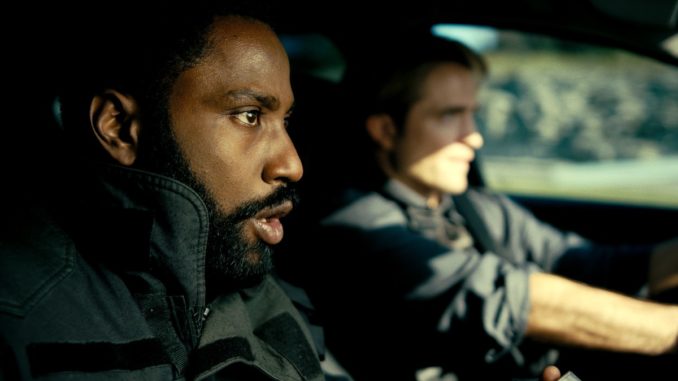
Facing delay after delay — a fate several media have borne for the past six months — Christopher Nolan’s “Tenet” finally released to theaters Sept. 3. Being his 11th project, Nolan continues to follow his tried-and-true formula — a bold piece of fiction obsessed with a concept, often told in a cerebral, nonlinear fashion. Although the word “formulaic” commonly connotes something bland or uninspired, Nolan’s films are anything but.
His stories often orbit around a single, ambitious idea that becomes central to the plots thereof. In “The Prestige,” for instance, he focuses on the idea of cloning and even dabbles in the more intangible realm of magic. With “Inception,” he plays around with dreams, and consequently dreams within dreams. For his latest venture, time — a concept Nolan teases in 2014’s “Interstellar” and now plunges into headfirst. With “Tenet” and its narrative fixation on time, Nolan presents his most confounding project yet.
At its most basic, genre level, “Tenet” is an action thriller that trickles into the sphere of espionage. On the hunt for an arms dealer who attacked him using mysterious ammunition during an operation, a nameless CIA officer — unequivocally dubbed The Protagonist — comes across an international secret society known as Tenet. He learns that Tenet is after the same man, a Russian arms dealer named Andrei Sator. The society believes Sator will usher in the dawn of a third world war, and recruits The Protagonist to put a stop to his plans. The intuitive portion of Nolan’s narrative ends here. What follows is a thought experiment of the grandest scale.
By joining Tenet, The Protagonist takes a crash course in controlling and utilizing a future technology that — bear with me here — reverses the entropy of certain objects, in essence flipping their flow through time. A character demonstrates this by “catching” a bullet that is reversed entropically, a concept called “inversion” by the film’s characters. Where a normal gun would shoot a normal bullet, an inverted gun catches an inverted bullet. The Protagonist must firmly understand this technology in order to pull off the mission Tenet has designed for him.
Regardless, it is clear that Nolan anticipates the struggle of following such a jargon-laden plot device, so he elects that a character express the sentiment, “Don’t try and understand it; feel it.” I recommend this approach as a viewer, though I wish the film didn’t need to say it in the first place. Nolan’s attempt is admirable, but there is something to be desired regarding exposition — it’s a rare thing indeed, asking for more exposition rather than less. In a film where most of the dialogue is expository to begin with, Nolan may have bitten off more than he could chew.

“Tenet” starts to shine as the plot gets underway. In order to contact Sator, The Protagonist first meets with the arms dealer’s wife Kat. Despite having an underlying despondence resultant of a controlling husband, Kat brings a cool composure to the tortured character and plays an integral part in the story to boot. Meanwhile, The Protagonist teams up with the charming Neil, who serves as a nice foil to our main character’s somewhat boring personality. All in all, the ensemble cast shapes up nicely, and provides a much-needed ground to an otherwise overwhelming film.
On a technical level, “Tenet” is nearly a masterpiece. One of Nolan’s directorial trademarks is his utilization of practical effects over computer-generated imagery or CGI, often lending his work a sense of genuineness that rarely falters, and “Tenet” certainly elicits this sense. Set piece after extensive and expensive set piece, I was in awe of the sheer scope Nolan manages to attain, much of the work accomplished sans green screen. Furthermore, the sound design is almost impeccable, with a tight and exciting score from Ludwig Göransson. There are times, however, where it is difficult to understand the dialogue, as scenes are regularly underscored with Göransson’s composition.
Lastly, “Tenet” boasts a number of impressive performances, most notably with the roles of Kat and Neil. Elizabeth Debicki embodies the bent-but-not-broken attitude of Kat flawlessly, and steals every scene she’s in. Robert Pattinson’s portrayal of Neil is equally realized, offering a smart-aleck type that is both suave and urgent when appropriate. Moreover, Kenneth Branagh brings a respectable, and often intimidating, performance as Andrei Sator, though his Russian accent could be more convincing. And, unfortunate as it is, John David Washington provides a rather dry portrayal with The Protagonist, a character I can only hope was made so blank so that the viewer might project themself onto the role and experience firsthand the confusion he is subjected to.
By the end of its 150-minute runtime, at which point I had surrendered to its confounding narrative, sat back and enjoyed the show, “Tenet” concludes effectively begging for a rewatch, and I’m here for it. Despite its overwhelming plot and performative mixed bag, the film flaunts a keen understanding of the filmmaking craft: big thrills, tireless action and a respect for cinema that directors like Nolan still carry in the age of streaming. If you’re willing to lend a keen eye and ear, then “Tenet” is willing to thrill you.
